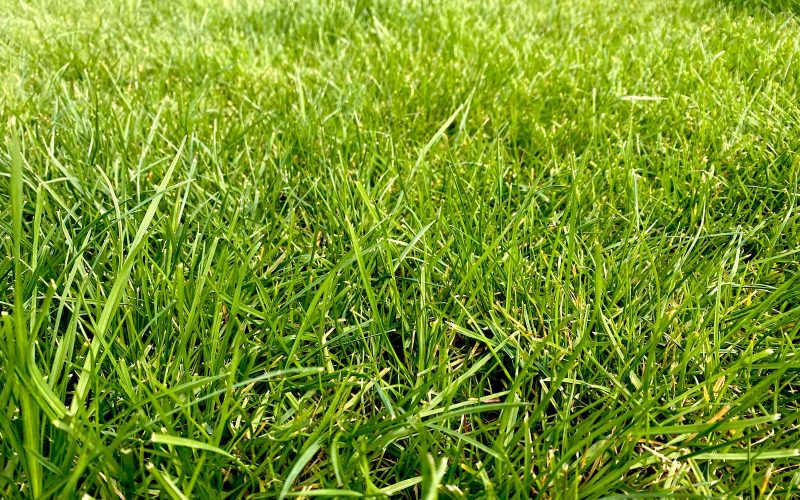When summer rolls around and you want a lush, green turf, you’ve got to do a few things ahead of time to prepare for the heat. Luckily, we’ve got you covered with helpful tips on how to prepare your lawn for the summer.
Getting Thick, Green Grass in Hot Summer Weather
If you live in a hot climate where you need to preserve water, you can’t just plant any old grass seed on your lawn. In the case of starting with bare ground, or if your lawn needs a complete overhaul, it might be worth starting anew with a new grass seed. There are several types of grass seed to consider based on your year-round weather.
Warm-season turfgrass seed is best for places with less intense winters and hot summers. The best places for these grasses are the western and southern regions of the United States.
Prepare for the summer heat with these grasses: St. Augustinegrass, Bermudagrass, Centipedegrass, Zoysiagrass, Bahiagrass, and Carpetgrass. These grasses grow quite well in the spring, summer, and fall months, turning brown and going dormant in the winter. They could even start to go dormant in temperatures of 65 degrees F.
When to Water Your Lawn In the Summer
Warm-season grasses need to be watered in the morning, at or right before sunrise, for a long time at less frequent intervals. Watering in the morning prevents oversaturation, which can lead to disease in your grass.
Space out watering times between 1-3 times per week, depending on your current climate and conditions. When you space out the watering times, it encourages your grass to grow deeper roots, allowing the grass to access more sources of water even when there are dry spells
When to Fertilize Your Lawn
In order to prepare your lawn for the summer, warm weather grasses need to be fertilized right after the first few mows of the spring and again in the late summer. In some areas, where the fall season is warmer, fertilizing will need to happen into the fall too. You may choose to fertilize your grass more often than that, if you feel it’s necessary.
You should not fertilize your warm turf grass right before the first active growth in the spring and 6 weeks before the first frost. Also, a month before the peak temperatures of the summer, you should stop fertilizing your lawn.
How to Fertilize Your Lawn for the Summer
As we already have mentioned, your lawn needs to be fertilized regularly in order to stay thick and green. Here are some fertilizing tips for your lawn to prepare for the summer.
Aerate Your Lawn
First, you need to make sure your grass can absorb whatever fertilizer and water you put down. You can either aerate your lawn yourself with a lawn aerator or hire a lawn service to do this for you. This should be done every 1 – 3 years, depending on how much traffic your grass gets. Cold-weather grass should be aerated in the fall, while warm-season grass needs to be aerated in the springtime.
Remove the Thatch From Your Lawn
Thatch is the dead organic material that accumulates on your lawn. Up to a half inch is okay, but much more than that will cause sunlight blockage and could prevent fertilizer and water from reaching the roots well. Thatch can be removed by raking the lawn in the fall with the leaves and in the spring while you’re aerating the lawn.
Apply Fertilizer to Your Lawn
Add a nitrogen-heavy fertilizer to warm-season grasses at the before-mentioned times. Fertilizing your lawn at the wrong times could hinder grass hardiness. We have reviewed the best lawn fertilizer spreaders so much sure you check them out!
Mowing Your Lawn
When you prepare to mow your lawn this summer, do not mow more than ⅓ of the grass height. Doing so can weaken the grass’s roots. Also, in the springtime, mowings should be more frequent to strengthen the growing grass.
When it’s summertime, raise the blades on your lawn mower to allow the grass to be uniformly a little longer. Doing so will help the grass shade the soil, causing better moisture retention in the soil.
Additional Summer Lawn Preparation Tips
Sometimes, when organic matter composts on your lawn, it causes hydrophobic soil. This soil creates a waxy coating on top, preventing water from absorbing through to the roots. You can purchase a wetting agent to help prevent this from happening.
When the grass looks more lackluster than usual, you could consider adding a pigment/fertilizer to your lawn. This will help your grass look better right away, while also providing some nutrients to the soil for the long run.
Conclusion
Although it takes some preparation, keeping your lawn green in the summer is not difficult to do, even when the water is short and the weather is hot. We hope this article has been helpful for you, and we wish you a warm and happy summer full of the smell of fresh-cut grass from your green lawn.






